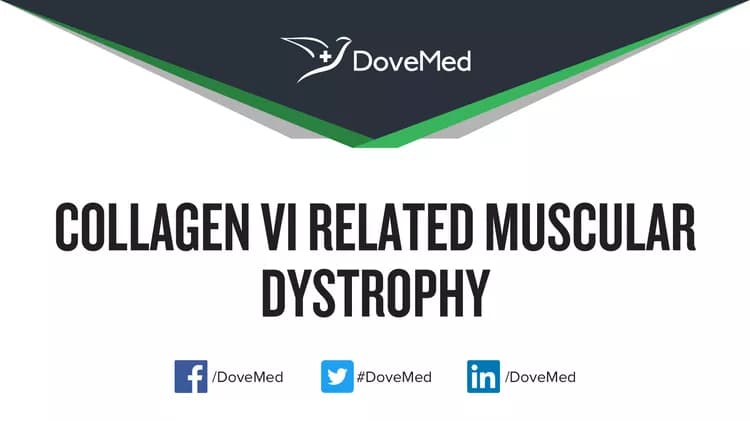What are the other Names for this Condition? (Also known as/Synonyms)
- Collagen Type VI-Related Disorders
- Collagen VI-Related Myopathies
- ColVI Myopathies
What is Collagen VI Related Muscular Dystrophy? (Definition/Background Information)
- Collagen VI Related Muscular Dystrophy are caused by alterations (mutations) of collagen genes (COL6A1, COL6A2, or COL6A3 genes) and include diseases that are mild like Bethlem myopathy or more severe like the Ullrich congenital muscular dystrophy (CMD)
- Diagnosis depends on typical clinical features, muscle biopsy (for suspected Ullrich CMD) or skin biopsy (for suspected Bethlem myopathy) and genetic testing that shows mutations in the collagen VI genes
- The treatment depends on the signs and symptoms that are present and may include physiotherapy regarding stretching exercises, splinting, and mobility aids and orthopedic surgeries
(Source: Collagen VI Related Muscular Dystrophy; Genetic and Rare Disease Information Center (GARD) of National Center for Advancing Translational Science (NCATS), USA.)
- Apart from the benign (Bethlem) and severe (Ullrich) forms of Collagen VI Related Muscular Dystrophy, an intermediate form of the disorder exists as well
- The intermediate type of Collagen VI Related Muscular Dystrophy is extremely rare, with very few cases reported in the scientific literature
Who gets Collagen VI Related Muscular Dystrophy? (Age and Sex Distribution)
- Collagen VI Related Muscular Dystrophy is a rare congenital disorder. It occurs at a frequency of approximately 7:100,000 for the benign type, and 1:1,000,000 for the severe, Ullrich type
- Very few cases of the intermediate type have been reported in the scientific literature
- The presentation of symptoms may occur at birth in the case of Ullrich type; and in infancy, for the benign and intermediate types of Collagen VI Related Muscular Dystrophy
- Both males and females may be affected
- Worldwide, individuals of all racial and ethnic groups may be affected
What are the Risk Factors for Collagen VI Related Muscular Dystrophy? (Predisposing Factors)
- A positive family history may be an important risk factor, since Collagen VI Related Muscular Dystrophy can be inherited
- Currently, no other risk factors have been clearly identified for the disorder
It is important to note that having a risk factor does not mean that one will get the condition. A risk factor increases one’s chances of getting a condition compared to an individual without the risk factors. Some risk factors are more important than others.
Also, not having a risk factor does not mean that an individual will not get the condition. It is always important to discuss the effect of risk factors with your healthcare provider.
What are the Causes of Collagen VI Related Muscular Dystrophy? (Etiology)
- Collagen VI Related Muscular Dystrophy is caused by mutation(s) in the COL6A1, COL6A2 and COL6A3 genes. These genes code for proteins that are components of collagen 6, which contributes to the extracellular matrix that surrounds muscles and connective tissue
- The mutations can occur de-novo, in individuals with no family history of the disorder
- The COL6A1, COL6A2 and COL6A3 gene mutations can also be inherited. The patterns of inheritance vary, with the Bethlem (benign) type inherited - predominantly in an autosomal dominant manner; the severe (Ullrich) type, in a predominantly autosomal recessive manner; and the intermediate type, following both patterns of inheritance
Autosomal dominant mode of inheritance: Autosomal dominant conditions are traits or disorders that are present when only one copy of the mutation is inherited on a non-sex chromosome. In these types of conditions, the individual has one normal copy and one mutant copy of the gene. The abnormal gene dominates, masking the effects of the correctly function gene. If an individual has an autosomal dominant condition, the chance of passing the abnormal gene on to their offspring is 50%. Children, who do not inherit the abnormal gene, will not develop the condition or pass it on to their offspring.
Autosomal recessive inheritance: Autosomal recessive conditions are traits or disorders that occur when two copies of an abnormal gene have been inherited on a non-sex chromosome. If both parents have an autosomal recessive condition, there is a 100% likelihood of passing on the mutated genes to their children. If, however, only one mutant copy of the gene is inherited, the individual will be a carrier of the condition, but will not be present with any symptoms. Children born to two carriers, have a 25% chance of being homozygous dominant (unaffected), a 50% chance of being heterozygous (carrier), and a 25% chance of being homozygous recessive (affected).
What are the Signs and Symptoms of Collagen VI Related Muscular Dystrophy?
The signs and symptoms of Collagen VI Related Muscular Dystrophy may vary in type, severity and age of onset, depending on whether an individual has the benign, intermediate, or severe form of the disorder.
The signs and symptoms of Collagen VI Related Muscular Dystrophy, Bethlem type, may include:
- Weak muscles that develop in childhood or early adulthood
- Loose joints
- Contractures in fingers, wrists, elbows and ankles
- Breathing problems
- Follicular hyperkeratosis
- Abnormal wound healing leading to shallow scarring
- Velvety skin in palms and soles
The signs and symptoms of Collagen VI Related Muscular Dystrophy, intermediate type, may include:
- Muscle weakness that often begins in infancy
- Loose joints
- Contractures in elbows, knees, ankles and spine
- Difficulty with walking
- Breathing difficulty, specifically while sleeping
The signs and symptoms of Collagen VI Related Muscular Dystrophy, Ullrich type, may include:
- Weak muscles that become apparent soon after birth
- Difficulties in feeding
- Loose joints in fingers, toes, wrists and ankles
- Contractures in neck, knees and hip
- Scoliosis
- Difficulty with movement
- Breathing distress
- Follicular hyperkeratosis
- Abnormal wound healing leading to shallow scarring
- Velvety skin in palms and soles
How is Collagen VI Related Muscular Dystrophy Diagnosed?
Collagen VI Related Muscular Dystrophy is diagnosed on the basis of the following information:
- Complete physical examination
- Thorough medical history evaluation
- Assessment of signs and symptoms
- Laboratory tests
- Imaging studies
- Biopsy studies, if necessary
- Molecular genetic testing to check or confirm COL6A1, COL6A2 or COL6A3 gene mutations
Many clinical conditions may have similar signs and symptoms. Your healthcare provider may perform additional tests to rule out other clinical conditions to arrive at a definitive diagnosis.
What are the possible Complications of Collagen VI Related Muscular Dystrophy?
The complications of Collagen VI Related Muscular Dystrophy may include:
- Inadequate weight gain, particularly in the Ullrich type
- Inability to walk, the age of onset of which may depend on the severity of the condition
- Bethlem type, typically when an individual is in his/her 50s
- Intermediate type, when an individual is in his/her early adulthood
- Ullrich type, a child may never walk or may do so only with support
- Severe back pain due to scoliosis
- Crowding of organs in the chest cavity due to scoliosis, which may affect the function of the lungs and heart
- Breathing distress due to weakness of muscles involved in respiration
Complications may occur with or without treatment, and in some cases, due to treatment also.
How is Collagen VI Related Muscular Dystrophy Treated?
There is no cure for Collagen VI Related Muscular Dystrophy, since it is a genetic condition. The treatment is usually given to manage the signs and symptoms and any complication that develops, and may include:
- Alternate feeding of a newborn with feeding problems to ensure proper nutrition
- Physiotherapy
- Use of a standing frame to ensure proper posture
- Walking aids, such as canes and wheelchairs
- Surgery to correct contractures or scoliosis
- Mechanical ventilators to aid in breathing
How can Collagen VI Related Muscular Dystrophy be Prevented?
Collagen VI Related Muscular Dystrophy may not be preventable, since it is a genetic disorder.
- Genetic testing of the expecting parents (and related family members) and prenatal diagnosis (molecular testing of the fetus during pregnancy) may help in understanding the risks better during pregnancy
- If there is a family history of the condition, then genetic counseling will help assess risks, before planning for a child
- Active research is currently being performed to explore the possibilities for treatment and prevention of inherited and acquired genetic disorders
- Regular medical screening at periodic intervals with tests and physical examinations are recommended
What is the Prognosis of Collagen VI Related Muscular Dystrophy? (Outcomes/Resolutions)
- The prognosis of Collagen VI Related Muscular Dystrophy is dependent upon the severity of the signs and symptoms and associated complications, if any
- Individuals with mild conditions have better prognosis than those with severe symptoms and complications
- Collagen VI Related Muscular Dystrophy is a progressive condition. The affected individuals may ultimately require assistance in walking and breathing
- Typically, the prognosis may be assessed on a case-by-case basis
Additional and Relevant Useful Information for Collagen VI Related Muscular Dystrophy:
The following DoveMed website link is a useful resource for additional information:
Related Articles
Test Your Knowledge
Asked by users
Related Centers
Related Specialties
Related Physicians
Related Procedures
Related Resources
Join DoveHubs
and connect with fellow professionals


0 Comments
Please log in to post a comment.